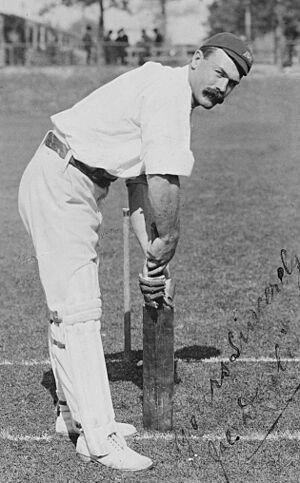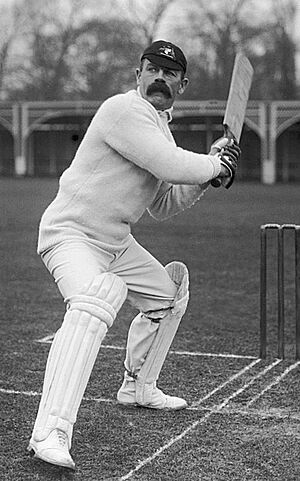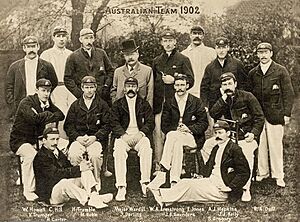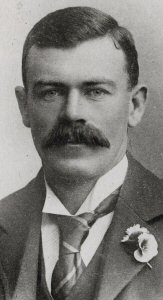Joe Darling facts for kids
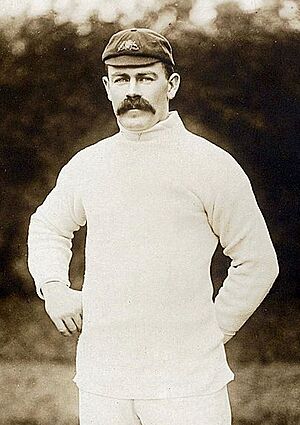
Darling in about 1905
|
||||||||||||||||||||||||||||||||||||||||
| Personal information | ||||||||||||||||||||||||||||||||||||||||
|---|---|---|---|---|---|---|---|---|---|---|---|---|---|---|---|---|---|---|---|---|---|---|---|---|---|---|---|---|---|---|---|---|---|---|---|---|---|---|---|---|
| Full name |
Joseph Darling
|
|||||||||||||||||||||||||||||||||||||||
| Born | 21 November 1870 Glen Osmond, South Australia |
|||||||||||||||||||||||||||||||||||||||
| Died | 2 January 1946 (aged 75) Hobart, Tasmania |
|||||||||||||||||||||||||||||||||||||||
| Nickname | Paddy | |||||||||||||||||||||||||||||||||||||||
| Height | 1.72 m (5 ft 8 in) | |||||||||||||||||||||||||||||||||||||||
| Batting | Left-handed | |||||||||||||||||||||||||||||||||||||||
| Role | Batsman | |||||||||||||||||||||||||||||||||||||||
| International information | ||||||||||||||||||||||||||||||||||||||||
| National side | ||||||||||||||||||||||||||||||||||||||||
| Test debut (cap 64) | 14 December 1894 v England | |||||||||||||||||||||||||||||||||||||||
| Last Test | 14 August 1905 v England | |||||||||||||||||||||||||||||||||||||||
| Domestic team information | ||||||||||||||||||||||||||||||||||||||||
| Years | Team | |||||||||||||||||||||||||||||||||||||||
| 1893/94–1907/08 | South Australia | |||||||||||||||||||||||||||||||||||||||
| Career statistics | ||||||||||||||||||||||||||||||||||||||||
|
||||||||||||||||||||||||||||||||||||||||
|
Source: CricketArchive, 10 February 2008
|
||||||||||||||||||||||||||||||||||||||||
Joseph Darling CBE (born 21 November 1870 – died 2 January 1946) was an Australian cricketer. He played 34 Test matches as a special batsman between 1894 and 1905. A Test match is the longest form of cricket, played over several days.
As a captain, he led Australia in 21 Tests. He won seven matches and lost four. In Test cricket, he scored 1,657 runs. His average was 28.56 runs per innings, including three centuries (scoring 100 runs or more in one innings).
Darling visited England four times with the Australian team: in 1896, 1899, 1902, and 1905. He was captain for the last three tours. He led the Australian cricket team in England in 1902, which many people think was one of Australia's best cricket teams ever.
He was a strong player who hit the ball powerfully. He often played as an opening batsman, meaning he was one of the first two players to bat. He was patient and good at defending his wicket, but he could also score runs quickly. In 1897–98, he scored 160 runs in just 165 minutes, including 30 boundaries (hits that reach the edge of the field). This helped his team beat England.
Joe Darling was the first player to score 500 runs in a Test series. He was also the first to score three centuries in one series. As a captain, he was strict but fair. His teammates respected his deep knowledge of cricket. He was calm and had a strong personality, always believing in fair play. His teammates called him "Paddy" because they thought he looked like the Australian boxer, Frank "Paddy" Slavin.
His cricket career was sometimes stopped because he was a farmer. First, he grew wheat in South Australia, and later, he raised sheep for wool in Tasmania. He was part of several groups that helped farming in Tasmania, including the group that ran the Royal Hobart Show. He also helped with new ideas like getting rid of rabbits and improving grasslands.
In 1921, he became a politician. He was an independent member of the Tasmanian Legislative Council, where he was a strong speaker. He stayed in the Tasmanian Parliament until he died in 1946 after a gall bladder operation.
Contents
Early Life and Cricket Start
Darling was born on 21 November 1870 in Glen Osmond, South Australia. He was the sixth son of John Darling, who was a grain merchant. Joe went to Prince Alfred College, where he loved cricket.
When he was 15, he scored a record 252 runs in the yearly match against their big rival, St Peter's College. Later, his future teammate, Clem Hill, broke this record by scoring 360 runs. Soon after, Joe played for a combined team from South Australia and Victoria against the main Australian team in 1886. He only scored 16 runs, but older players saw how he played and said he would be a future star.
His father did not like how much Joe loved sports. So, he sent Joe away from his cricket and Australian rules football teams. Joe spent a year at Roseworthy Agricultural School. Later, Joe worked in a bank for a while. Then, his father made him manager of a wheat farm. Working on the farm made Joe stronger and bigger.
He was chosen for the South Australian team when he was 19. But his father would not let him take time off the farm to play. After two years, Darling came back to Adelaide and cricket. He opened a sports shop and was soon chosen to play for South Australia in important matches. He played his first first-class cricket match against New South Wales. He scored five and 32 runs, and South Australia won. The next season, he scored 115 runs against the touring England team. This was his first century in a first-class match.
Test Cricket Career
Becoming a Key Player
Joe Darling played his first Test match in 1894–95 against England. This game was at the Sydney Cricket Ground. Australia scored 586 runs in their innings, but Darling was out for a "golden duck" (out on the first ball) by Tom Richardson. He played in all five Tests in that series, scoring 258 runs with an average of 28.66.
He was chosen for the Australian team to tour England in 1896. There, he scored the most runs for the tour, with 1555 runs at an average of 29.90, including three centuries. Wisden Cricketers' Almanack, a famous cricket book, said Darling was "perhaps the best of present-day left-handed batsmen" during that tour. England won the series two Tests to one.
Another English team came to Australia in 1897–98 to play for The Ashes. Australia won this series easily, four Tests to one. Darling started the season poorly, scoring zero and one run against the English for South Australia. But then he started to play very well. His first Test century was 101 runs in the First Test in Sydney. This was the first century by a left-handed player in Test matches. However, England still won that match.
In the Third Test in his hometown of Adelaide, Darling scored 178 runs. Australia won the match by an innings and 13 runs. He hit the ball over the eastern gate and into a nearby park to reach his century. This is the only time in Ashes Tests that a player has reached 100 by hitting the ball out of the ground. He also became the first player to hit a six in a Test in Australia (before 1910, a six was only given if the ball left the ground). He later hit the first six in a Test in England too.
In the Fifth and final Test in Sydney, Darling scored 160 runs. He batted for 165 minutes, hitting 30 boundaries. Australia successfully chased 273 runs to win. His first 100 runs came in just 91 minutes, which was the fastest Test century at that time. By the end of the season, Darling was the first player to score 500 runs in a series. He was also the first to score three centuries in a series.
Leading the Team
Darling's teammates chose him as captain for the 1899 Australian team touring England. This team was one of the strongest England had seen. Wisden said they were "the strongest combination that had come from the Colonies since the great side captained by Mr. W. L. Murdoch in 1882." They also said Darling was "one of the very best captains that ever took a team into the field."
The Australians lost only three of their 35 matches on the tour. They won 16 and drew 16. The only Test match they won was the Second Test at Lord's. Australia won by ten wickets, thanks to centuries by Hill and Victor Trumper and many wickets taken by fast bowler Ernie Jones. Wisden thought Darling was the best batsman after Hill. They said, "Up to a certain point the responsibilities of captaincy seemed to tell against Darling, but during the last weeks of the tour he played marvellous cricket." He scored 1941 runs on the tour and was named one of the Wisden Cricketers of the Year.
Joe's success in cricket made his father happy, but his father still did not like Joe's sports shop. In 1900, his father bought "Stonehenge," a sheep station (a large farm for sheep) in central Tasmania. He told Joe to run the farm, or he would not get anything in his father's will (money or property left after death). Joe agreed and moved his family to the farm, which was 34 kilometers (21 miles) from the nearest small town, Oatlands. Joe did not play first-class cricket for almost two years.
In December 1901, the Melbourne Cricket Club convinced Darling to return. He agreed to captain Australia against the touring English team for only the first three Tests. The English team won the First Test easily. The Second Test in Melbourne was played on a pitch affected by rain. Darling won the toss and chose to bat first on the "sticky wicket" (a wet, difficult pitch). Both teams were out within three hours. Australia had a lead of 51 runs.
Knowing the pitch was dangerous for his best batsmen, Darling changed the batting order. He opened the batting himself with Hugh Trumble. They stayed at the wicket for 90 minutes. Darling thought his 32 runs were one of his best innings. Australia eventually won the Test by 229 runs. In the Third Test in Adelaide, Australia made history by scoring over 300 runs to win in the fourth innings of a Test match. Darling, along with Hill and Trumble, helped achieve this record. Darling scored 62 runs. Hugh Trumble captained the last two Tests as Darling went back to his farm. Australia won both Tests and the series.
Coming Back to Cricket
Darling agreed to lead the Australian cricket team in England in 1902 again. It was a very cold and wet summer, but the Australian team won a close series against a strong English team, two Tests to one. Because the English team was so good, this Australian team is often called one of the best Australian teams ever. The team had amazing players like Trumper, Hill, Armstrong, Trumble, and Monty Noble. All of them are now in the Australian Cricket Hall of Fame. The team lost only two matches during the tour. Wisden said, "No travelling team ever strove harder for victory or more completely subordinated all personal considerations to the prime object of winning matches. They formed a splendid all-round combination."
The First Test at Edgbaston ended in a draw. Rain saved the Australians after they were out for only 36 runs in their first innings. Rain also ruined the Second Test at Lord's. The Third Test, played at Bramall Lane, saw Australia win by 143 runs. Darling was out twice without scoring in this match. Australia won the Fourth Test at Old Trafford by just three runs. Trumble took ten wickets in the match. The last English batsman, Fred Tate, came in needing eight runs to win. Darling brought the fielders closer, and Trumble stopped Rhodes from scoring. Tate then faced Jack Saunders, who got him out to win the match for Australia. England won the Fifth and final Test at the Oval by one wicket.
The star for Australia was Trumper, who scored 2,570 runs, easily breaking Darling's record for an Australian batsman in an English season. Trumper was so important that Darling, who used to check if all Australians were on the bus to the ground, later just asked, "Is Vic aboard?" before telling the driver to go. Darling himself had mixed results with the bat on this tour.
Darling started the tour in a way that promised great things, but he did not keep up his form and fell a good deal below his standard of 1896 and 1899. His tremendous hitting power, however, was several times of the utmost value, and very likely in a season of hard wickets he would have had as good a record as ever.
On the way back to Australia, the team stopped to play three Tests against South Africa. These were the first matches between the two countries. Australia won the series two Tests to nil, but Darling's own performance was poor. After the tour, he returned to Stonehenge and took a two-year break from first-class cricket. During his absence, Monty Noble captained the Australian team.
Last Tour and Retirement
Before the Australian team for the 1905 tour to England was chosen, Darling played first-class cricket again for South Australia. He was selected for the touring team and named captain. Australia's bowling attack (the players who bowl the ball) was weaker this time. So, Darling used defensive tactics during the tour. This included telling Armstrong to bowl his leg breaks (a type of spin bowling) down the leg side, where Darling placed up to seven fielders. These tactics were not popular with the English public. As a result, 19 matches on the tour ended in draws, while Australia won 16.
Wisden said, "Leaving aside Duff's long score at the Oval, Darling was the finest batsman on the side in the Test games, playing superb cricket under very trying conditions." At Old Trafford in the Fourth Test, he scored 73 runs out of 105 in less than 90 minutes. His innings included 13 boundaries, mostly drives (a type of shot). Even with his efforts, England still won the Test.
Darling lost six coin tosses against his English opponent Stanley Jackson that summer. So, before a match later in the tour, Darling tried a different approach. At the toss, he approached Jackson without his shirt and jokingly suggested they wrestle for the choice of who batted first.
The 1905 tour was Darling's last Test cricket trip. He said that continuing to tour was not fair to his wife. He stopped playing first-class cricket during the 1907–08 season. In his first-class career, Darling scored 10,635 runs, including 19 centuries, with an average of 34.52. In club cricket in Adelaide, Joe scored many runs. He averaged 144 for East Torrens Cricket Club in 1899–1900. He continued to score runs in Tasmanian club cricket even when he was older. In 1921, he scored 100 runs in an hour. At age 52, he scored 133 not out.
He did not like the newly formed Australian Board of Control for International Cricket Matches (now called Cricket Australia). He thought they were trying to take control of international cricket tours away from the players. He often called cricket leaders "Dead Heads." Later, he represented the Tasmanian Cricket Association as a delegate to the Board of Control.
Life Outside Cricket
After he stopped playing big cricket, Darling went back to his sheep farm in Tasmania. He was involved in many farming activities. He was a pioneer in getting rid of rabbits, which were a huge problem in Australia. He was an active member of groups like the Tasmanian Stock Holders and Orchardists' Association and the Royal Agricultural Society of Tasmania, which organizes the Royal Hobart Show. Darling brought special sheep from South Australia to improve his flock. His wool often sold for the highest prices in Hobart. He also brought a new type of clover plant to Tasmania.
In 1919, Darling moved from Stonehenge to Claremont House, where the Hobart suburb of Claremont later grew. He was elected to the Cambridge area in the Tasmanian Legislative Council in 1921. He was an independent politician. He stayed in Parliament until he died in 1946. One of his colleagues in Parliament was Charles Eady, who was his teammate from the 1896 tour of England. Darling was known as a strong and direct speaker.
In the 1930s, he helped small farmers get an exemption from land tax. Towards the end of his time in Parliament, a Royal Commission (a special investigation) was set up to look into charges Darling had made about bad management. The findings, released after his death, showed that a government Minister and two others were guilty of taking bribes. Darling was made a Commander of the Order of the British Empire (CBE) in 1938 for his work as a member of the Legislative Assembly.
Darling married Alice Minna Blanche Francis in 1893. She was a wheat farmer's daughter. They had 15 children: ten sons and five daughters. Darling died in Hobart on 2 January 1946, after surgery for a ruptured gall bladder. He was buried after a church ceremony. His wife and twelve of his children survived him.
Playing Style and Personality
Darling had a strong, compact body. He was 1.72 meters (5 feet 8 inches) tall and weighed 81.6 kilograms (12 stone 12 pounds). His teammates thought his dark hair, blue eyes, and mustache looked like the boxer, Frank "Paddy" Slavin. So, they called him "Paddy." Working on his father's farm made him very strong. In his first game for South Australia, the fast bowler Ernie Jones challenged him to a wrestle. To everyone's surprise, Darling beat the much bigger Jones.
Darling was a left-handed batsman who hit the ball powerfully. He was also a very good defender of his wicket when needed. His teammates sometimes thought he was too defensive. They believed he played his best when he hit the ball hard. His teammate George Giffen said that no Australian's cut shots (a type of shot) went faster past the point fielder.
Darling is a remarkable combination of stolidity and power. His driving, whenever he choose to let himself loose, is tremendous, and no left-handed batsman, at any rate in our time, has possessed quite such a defence. He always gives one the idea of being a great natural hitter, who has rigorously schooled himself to play the steady game.
Darling holds the record for playing the most innings in a full Test match career (60 innings) without ever being out lbw (leg before wicket, a way of getting out).
Darling had a strong personality and thought for himself. People who knew him well believed he was meant to be a leader in anything he did. He did not drink alcohol or smoke. He was usually calm, but he did show annoyance when the crowd at Lord's booed him for playing too defensively. He believed in fair play. However, his actions against the English batsman KS Ranjitsinhji would be seen as gamesmanship today. While the bowler was running up, Australian fielders moved behind Ranjitsinhji's back. This made the Indian prince worried when he tried to play his leg glance (a type of shot). This eventually led to him being left out of the English team.
The journalist Ray Robinson wrote that "of all Australian captains he came closest to being a disciplinarian." Still, his teammates kept choosing him as captain because they trusted his knowledge of the game. One wet day during the 1899 tour, some Australians went to a tobacco factory during a rain delay. The weather cleared, and play started with Darling leading a team of five Australians and five substitute players. Darling later held a team meeting, and the players who left were fined £5 for breaking team rules. As a captain, he wanted to change rules. He suggested giving six runs for hitting the ball over the boundary, not just out of the whole ground. He also suggested using sawdust to fill holes in the bowler's run-up area.
Images for kids
See also
- List of South Australian representative cricketers


